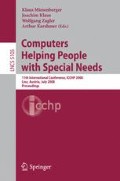Abstract
Design for all (DfA) is on the agenda of research for more than 10 years. It is to be seen as a complement to concepts like assistive technology and barrier free accessibility in a continuum of solutions. After several national policy actions around the globe, recently on international policy level, in the “UN Convention on the Rights of Persons with Disabilities”, reference has been given to Universal Design, a concept closely related to DfA. However, the level of take up of DfA in the design processes of industries and services stays behind the expectations. The idea has obviously been welcomed as a good one, but the implementation shows slow progress. The current development consists of threats and challenges towards a successful implementation of DfA and the market opportunities connected. “What are the key elements, what are the actions needed, which could be the next steps” are the kind of questions to be answered in order to conclude with a DfA roadmap and reflected in this paper.
Access this chapter
Tax calculation will be finalised at checkout
Purchases are for personal use only
Preview
Unable to display preview. Download preview PDF.
References
BBGG, Gesetz zur Gleichstellung behinderter Menschen, 2.2007 (2002), http://bundesrecht.juris.de/bgg/index.html
Bühler, C.: Ensuring access for all, the role of telecommunications systems for elderly and those with special needs, EC contract 48422, European Commission, ESC-ECEAEC, Brussels-Luxembourg (1999)
Bühler, C., Knops, H.: Assistive Technology at the Threshold of the New Millennium. AT Research Series, vol. 6. IOS Press, Amsterdam (1999)
Bühler, C.: Empowered participation of users with disabilities in universal design. Int. Journ. Universal Access in the Information Society 1(2) (October 2001)
Bühler, C.: eEurope - Accessibility - User Participation; Participation of People with Disabilities and Older People in the Information Society. In: Miesenberger, K., Klaus, J., Zagler, W. (eds.) ICCHP 2002. LNCS, vol. 2398, pp. 3–5. Springer, Heidelberg (2002)
Bühler, C., Stephanidis, C.: European Co-operation Activities Promoting Design for All in Information Society Technologies. In: Miesenberger, K., Klaus, J., Zagler, W., Burger, D. (eds.) ICCHP 2004. LNCS, vol. 3118, pp. 80–87. Springer, Heidelberg (2004)
CEU, 2001, COM (2001) 529 final, eEurope 2002: Accessibility of Public Web Sites and their Content, Communication from the Commission to the Council, the European Parliament, the European Economic and Social Committee and the Committee of the Regions: Brussels (2001)
CEU, 2002 (European Commission), IST work programme and cross programme themes, Design for all, 2.2007, http://cordis.europa.eu/ist/cpt/designforall.htm
CEU, 2004 (European Commission), Applications relating to persons with special needs including the disabled and elderly, 2.2007, http://cordis.europa.eu/ist/ka1/special_needs/projects/projects_domain.htm
CEU, 2005,COM (2005) 229 final, i2010 - A European Information Society for growth and employment, Communication from the Commission to the Council, the European Parliament, the European Economic and Social Committee and the Committee of the Regions, Brussels (2005)
COST 219 bis: Bridging the Gap? Access to telecommunications for all people (2001)
Council of Europe, 2003, e-Accessibility: improving the access of people with disabilities to the knowledge based society, Resolution 5165/03, OJ 14 (January 2003)
EDeAN, 2004, “About”, 2.2007, http://www.edean.org/
EDeAN 2005, White Paper: Promoting Design for All and e-Accessibility in Europe, 2.2007, http://www.edean.org/
EDeAN, EDeAN Standardisation Documents area, 2.2007 (2006), http://www.edean.org/
eEurope Standards, eAccessibility standardisation activities, 2.2007 (2007), http://eeurope-standards.org/activities_e-accessibility.htm
Ellis, G.: From Information Age to Inclusive Age, The Economic Concept of Inclusion. AT Research Series, vol. 11, pp. 19–24. IOS Press, Amsterdam (2003)
European Commission, eEurope 2005 Action Plan. 2.2007 (2002), http://europa.eu.int/information_society/eeurope/2002/news_library/documents/eeurope2005/eeurope2005_en.pdf
Mace, R.: Universal Design in Housing, Assistive Technology, vol. 10, pp. 21–28. IOS Press, Amsterdam (1998)
Mueller, J.: Assistive Technology and Universal Design in the Workplace, Assistive Technology, vol. 10, pp. 37–43. IOS Press, Amsterdam (1998)
Pacific Bell, 2.2007, http://trace.wisc.edu/docs/pacbell_ud/agpd.htm
Preiser, W.F.E., Ostroff, E. (eds.): Universal Design Handbook. McGraw-Hill, New York (2001)
Stephanidis, C. (ed.): Toward an Information Society for All: An International R&D Agenda. International Journal of Human - Computer Interaction, 10 (2), 107–134 (1998), http://www.ics.forth.gr/hci/html/files/white_paper_1998.pdf
SUN, 2.2007, http://www.sun.com/access/developers/updt.HCI.advance.html
UDA, Universal Design Alliance, 2.2007 (2003), http://www.universaldesign.org/
ud-net Universal Design Network, 2.2007 (1999), http://www.universaldesign.net/
US Access Board: The Rehabilitation Act Amendments (Section 508), 2, 2007 (1998), http://www.access-board.gov/sec508/guide/act.htm
Vanderheiden, G.C.: Universal design, Trace R&D Center. University of Wisconsin-Madison, Rev. 5/6/9, 6 2.200, 7 (1996), http://trace.wisc.edu/world/gen_ud.html
Author information
Authors and Affiliations
Editor information
Rights and permissions
Copyright information
© 2008 Springer-Verlag Berlin Heidelberg
About this paper
Cite this paper
Bühler, C. (2008). Design for All – from Idea to Practise. In: Miesenberger, K., Klaus, J., Zagler, W., Karshmer, A. (eds) Computers Helping People with Special Needs. ICCHP 2008. Lecture Notes in Computer Science, vol 5105. Springer, Berlin, Heidelberg. https://doi.org/10.1007/978-3-540-70540-6_14
Download citation
DOI: https://doi.org/10.1007/978-3-540-70540-6_14
Publisher Name: Springer, Berlin, Heidelberg
Print ISBN: 978-3-540-70539-0
Online ISBN: 978-3-540-70540-6
eBook Packages: Computer ScienceComputer Science (R0)

